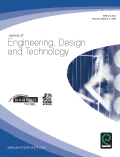
Journal of Engineering Design and Technology
Scope & Guideline
Innovating Solutions through Rigorous Peer Review
Introduction
Aims and Scopes
- Engineering Design Methodologies:
The journal emphasizes the development and application of new engineering design methodologies, including BIM (Building Information Modeling), digital twin technology, and advanced simulation techniques. - Sustainability and Resilience in Construction:
A core focus area is on sustainable construction practices and resilience-building strategies, addressing the environmental impact and sustainability of materials and processes. - Project Management and Performance:
Research on project management strategies, leadership roles, and their impact on project performance is a significant aspect, exploring factors that contribute to successful outcomes. - Technology Integration in Construction:
The journal highlights the integration of emerging technologies such as IoT, blockchain, and big data analytics in construction processes to improve efficiency and decision-making. - Health and Safety in Construction:
There is a consistent emphasis on health and safety practices within the construction industry, assessing the influence of organizational culture and safety management systems. - Policy and Economic Aspects:
The journal also addresses the economic and policy-related factors affecting construction practices, particularly within developing economies, focusing on public-private partnerships and regulatory frameworks.
Trending and Emerging
- Digital Transformation and Smart Technologies:
There is an increasing trend towards research on digital transformation, including the use of smart technologies like IoT and AI in construction, enhancing operational efficiency and data management. - Sustainable Construction Practices:
Emerging studies focus on sustainability, including the use of eco-friendly materials and methods, as well as frameworks for circular economy practices in construction. - Impact of COVID-19 on Construction:
Research examining the effects of the COVID-19 pandemic on construction practices, project management, and workforce dynamics has become increasingly relevant, highlighting the need for adaptive strategies. - Advanced Data Analytics in Construction:
The utilization of big data analytics and machine learning for predictive modeling and performance assessment in construction projects is on the rise, reflecting a shift towards data-driven decision-making. - Health and Well-being in Construction Workplaces:
Emerging themes around workplace health and mental wellness are gaining attention, with studies exploring the impact of organizational culture on worker well-being and safety. - Collaboration and Stakeholder Engagement:
Research focused on enhancing collaboration among various stakeholders through integrated project delivery methods and stakeholder management strategies is becoming more prevalent.
Declining or Waning
- Traditional Construction Practices:
There is a noticeable decline in research centered around conventional construction practices, as the focus shifts towards innovative, technology-driven approaches. - Generalized Risk Management:
While risk management remains important, the breadth of general risk management strategies has decreased, with a more concentrated emphasis on specific technologies and methodologies instead. - Historical Perspectives on Construction:
Research that focuses solely on historical perspectives or case studies from earlier construction practices is less frequent, as the journal pivots towards contemporary issues and future-oriented solutions. - Basic Material Studies:
There seems to be a reduction in studies that purely focus on basic material properties without the context of innovative applications or sustainability considerations. - Non-technical Aspects of Construction:
Themes related to non-technical aspects, such as basic human resources or administrative processes unrelated to project outcomes, are receiving less focus.
Similar Journals
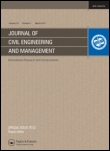
Journal of Civil Engineering and Management
Empowering professionals with cutting-edge insights in civil engineering.Journal of Civil Engineering and Management, published by Vilnius Gediminas Technical University in Lithuania, is a prominent open access journal dedicated to the dissemination of cutting-edge research in both civil and structural engineering as well as strategic management. With the ISSN 1392-3730 and E-ISSN 1822-3605, this journal has been an essential resource for academics and industry professionals since its inception in 2002 and has continued through to 2024. Recognized for its high-quality publications, it ranks in the Q2 quartile in both the fields of Civil and Structural Engineering and Strategy and Management, reflecting its significant impact in the academic community with a Scopus ranking of #75 out of 379 and #121 out of 478 respectively. The journal embraces an open-access model, promoting wider distribution and accessibility of knowledge to foster innovation and collaborative advancements in construction practices and management strategies. It serves as a vital platform for researchers, professionals, and students looking to contribute to and stay informed about the latest developments in these dynamic fields.

JOURNAL OF CONSTRUCTION ENGINEERING AND MANAGEMENT
Elevating Standards in Construction ResearchJournal of Construction Engineering and Management, published by the American Society of Civil Engineers (ASCE), is a premier scholarly journal dedicated to advancing the field of construction engineering and management. With an ISSN of 0733-9364 and an E-ISSN of 1943-7862, this respected journal boasts a noteworthy impact factor and is categorized in the Q1 quartile across significant fields such as Building and Construction, Civil and Structural Engineering, and Strategy and Management. Covering a broad spectrum of topics relevant to professionals, researchers, and students from its inception in 1982 through 2024, the journal emphasizes innovative research and practical applications that are vital to the construction industry. While it is not an open-access journal, it provides essential insights into the evolving dynamics of construction management, regulatory changes, and technological advancements, making it an indispensable resource for anyone looking to stay at the forefront of their field.
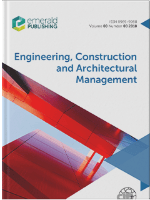
Engineering Construction and Architectural Management
Leading the Charge in Engineering and Construction ResearchEngineering Construction and Architectural Management is a prestigious journal published by Emerald Group Publishing Ltd, dedicated to advancing knowledge and practice at the intersection of engineering, architecture, and construction management. With an ISSN of 0969-9988 and an E-ISSN of 1365-232X, this journal fosters a scholarly environment for researchers, professionals, and students to explore innovative methodologies and developments within the field. Operating without Open Access, it has maintained a strong reputation since its inception in 1994, with a converged publication timeline extending to 2024. The journal proudly boasts a Q1 ranking in four critical categories for 2023, including Architecture and Building and Construction, highlighting its role as a leading source for groundbreaking research. Additionally, with impressive Scopus Rankings—such as #5 in Architecture (97th percentile) and #28 in Building and Construction (87th percentile)—it underscores its dedication to excellence in scholarly contributions. By addressing key challenges and emerging trends in the industry, Engineering Construction and Architectural Management serves as an essential resource for those striving to shape the future of engineering and architectural practices.
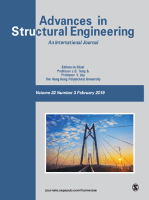
ADVANCES IN STRUCTURAL ENGINEERING
Elevating Knowledge in Civil and Structural EngineeringADVANCES IN STRUCTURAL ENGINEERING, published by SAGE PUBLICATIONS INC, is a leading journal dedicated to the advancement of knowledge in the fields of Building and Construction, as well as Civil and Structural Engineering. With a solid impact factor and a commendable Scopus ranking (Rank #60 in Building and Construction, Rank #105 in Civil and Structural Engineering), this journal stands at the forefront of academic research, providing a platform for high-quality articles that contribute significantly to the discipline. Covering a range of topics from innovative construction techniques to sustainable engineering practices, the journal aims to foster collaborative dialogue among researchers, industry professionals, and students alike. As of 2023, it boasts impressive category quartiles, ranking Q1 in Building and Construction and Q2 in Civil and Structural Engineering. ADVANCES IN STRUCTURAL ENGINEERING is a vital resource for those looking to stay abreast of emerging trends and groundbreaking developments in structural engineering, promoting an environment of continuous learning and application of best practices. With a convergence of research from 1999 to 2024, the journal not only emphasizes theoretical frameworks but also bridges the gap between academia and practical application in engineering projects.

Gradevinar
Elevating Standards in Civil Engineering Research and PracticeGradevinar, published by the Croatian Society of Civil Engineers-HSGI, is a leading Open Access journal in the field of Civil and Structural Engineering, with a significant history that dates back to its inception in 1980. This journal, with the ISSN 0350-2465 and E-ISSN 1333-9095, has established itself as a vital platform for disseminating innovative research and practical developments in civil engineering, particularly since it became Open Access in 2000, facilitating unrestricted access to its wealth of knowledge. As of 2023, Gradevinar is ranked in the third quartile (Q3) of Scopus’s Civil and Structural Engineering category, demonstrating its growing influence and relevance in the academic community, with a current ranking of #255 out of 379 journals in the field. Researchers, professionals, and students benefit from this journal's commitment to high-quality content that reflects the latest advancements and best practices in civil engineering, contributing to both technical proficiency and sustainable development in infrastructure projects across Croatia and beyond.

JOURNAL OF COMPUTING IN CIVIL ENGINEERING
Innovative Insights at the Intersection of Engineering and Technology.JOURNAL OF COMPUTING IN CIVIL ENGINEERING is a leading publication in the field of civil and structural engineering, with a specific focus on the application of computer science techniques in civil engineering projects. Published by the ASCE - American Society of Civil Engineers, this esteemed journal has been at the forefront of innovative research since its inception in 1987 and continues to maintain high academic standards with a remarkable impact factor. Achieving a prestigious Q1 ranking in both Civil and Structural Engineering and Computer Science Applications, it holds a commendable position within the top percentiles of Scopus ranks, at 94th and 91st respectively. The journal serves as a vital resource for researchers, practitioners, and students aiming to explore the integration of computational technologies and methodologies in civil engineering practices. By publishing cutting-edge research, it aims to advance knowledge and foster collaboration within the field, contributing significantly to the development of efficient, sustainable, and innovative engineering solutions.

Practice Periodical on Structural Design and Construction
Innovating Design, Elevating ConstructionPractice Periodical on Structural Design and Construction, published by the American Society of Civil Engineers (ASCE), is a vital resource within the fields of civil and structural engineering. With an ISSN of 1084-0680 and an E-ISSN of 1943-5576, this journal aims to disseminate innovative research and practical applications that enhance the design and construction process. Recognized in the 2023 Scopus rankings with commendable placements across categories, including a Q2 designation in Building and Construction, this journal serves as a platform for discourse on the latest advancements and case studies in structural engineering. Though not an Open Access publication, it continues to facilitate the exchange of knowledge and expertise among researchers, professionals, and students engaged in the built environment. The editorial board encourages submissions that contribute to the understanding of sustainable practices, innovative technologies, and effective construction methodologies to meet the evolving needs of infrastructure development.

Built Environment Project and Asset Management
Transforming Knowledge into Practice in the Built EnvironmentBuilt Environment Project and Asset Management is an esteemed academic journal published by Emerald Group Publishing Ltd, dedicated to advancing knowledge and research within the fields of architecture, building and construction, civil and structural engineering, and urban studies. With an impressive impact factor reflected in its Q1 and Q2 rankings across various categories, the journal serves as a critical platform for scholars, practitioners, and students seeking to explore the intersections of project management and asset optimization in the built environment. Covering a breadth of topics from sustainable construction practices to innovative management strategies, Built Environment Project and Asset Management promotes high-quality studies and practical applications that contribute significantly to the discipline. With a commitment to the dissemination of impactful research, this journal is a vital resource for those aiming to influence policy and practice in the evolving landscape of the built environment.
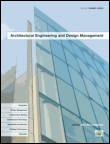
Architectural Engineering and Design Management
Pioneering advancements in design management and construction processes.Architectural Engineering and Design Management, published by Taylor & Francis Ltd, is a leading journal dedicated to the interdisciplinary fields of architectural engineering and design management. Since its inception in 2005, the journal has established itself as an essential resource for researchers and practitioners, showcasing the latest developments and innovative practices within the architecture and construction industries. With a commendable impact factor reflected in its Q1 ranking in Architecture and high standings across building and construction, it addresses critical themes such as sustainable design, integrated construction processes, and management strategies that drive efficiency and creativity in evolving architectural contexts. Researchers will find the journal's commitment to disseminating high-quality research—evidenced by its impressive Scopus rankings, including a #13 ranking in Architecture—particularly valuable as it fosters a deeper understanding and advancement in the profession. The journal is accessible in print and online, ensuring that academic and professional communities stay at the forefront of architectural engineering innovation.

Civil Engineering Journal-Stavebni Obzor
Fostering Collaboration for a Sustainable FutureWelcome to the Civil Engineering Journal-Stavebni Obzor, an esteemed academic publication dedicated to advancing the field of civil engineering. Published by the Czech Technical University in Prague, Faculty of Civil Engineering, this journal has provided a platform for innovative research and critical discourse since its inception. With an ISSN of 1210-4027 and an E-ISSN of 1805-2576, this Open Access journal has been facilitating wide dissemination of knowledge in civil engineering since 2014, ensuring that valuable research reaches a global audience without barriers. The journal is committed to fostering collaboration among researchers, professionals, and students, encouraging the exchange of ideas that drive the discipline forward. Its diverse scope encompasses various aspects of civil engineering, making it an essential resource for anyone looking to stay at the forefront of this dynamic field. Located in Prague, a hub of engineering excellence, this journal not only reflects the latest trends and innovations but also contributes to shaping the future of civil engineering.